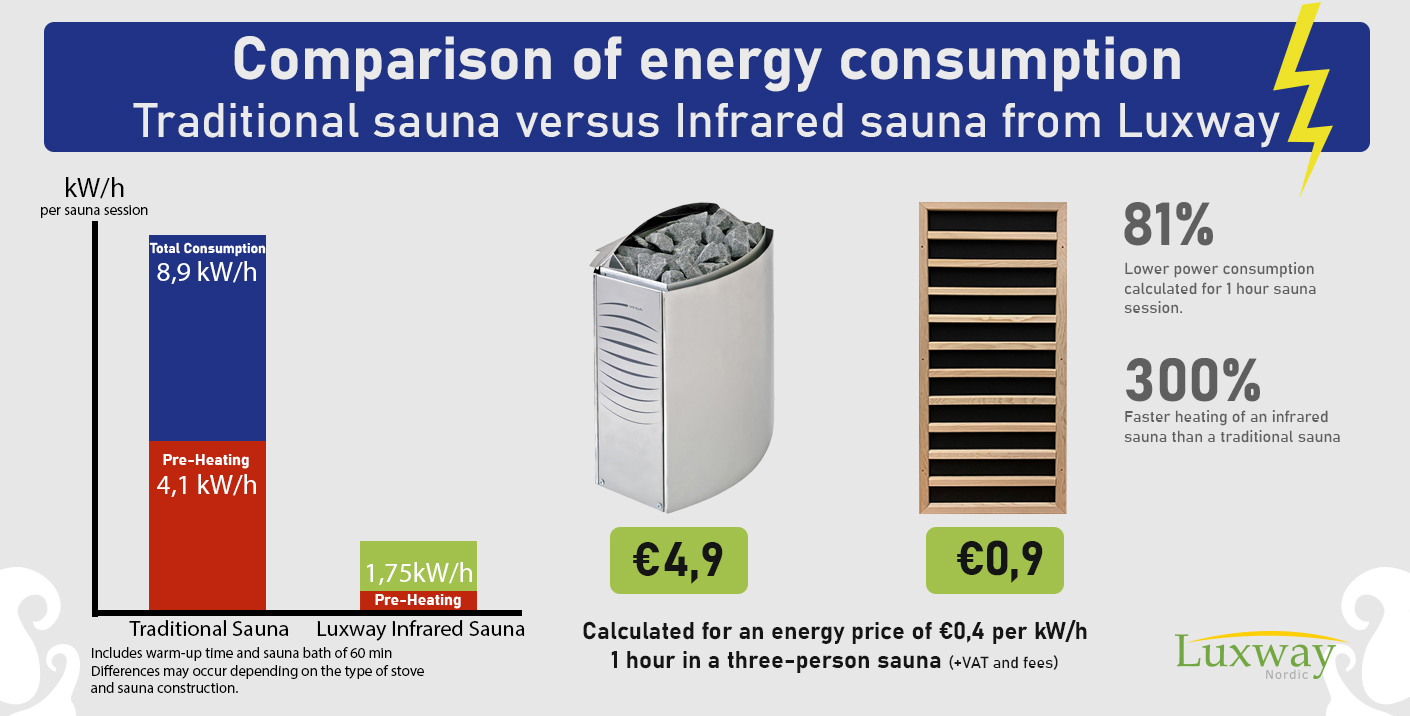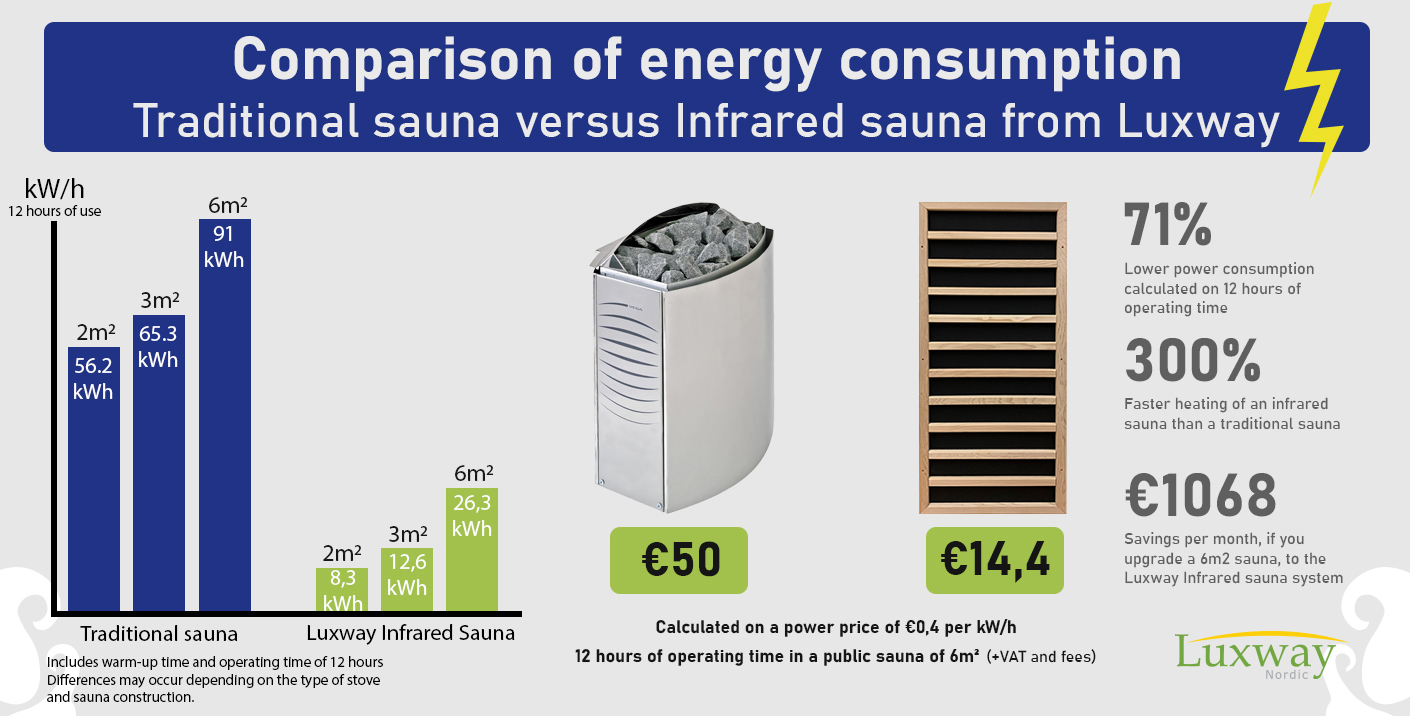There are many reasons for choosing an infrared sauna, but energy saving is a very important reason.
Electricity prices are sky high and it will cost society and ordinary households a lot. Below we explain the principle of an energy-efficient infrared sauna and how it generates energy and is very climate-smart and energy-efficient in comparison to a sauna that is heated in the old traditional way via electric units with hot air, also called convection heating.
How does an infrared sauna work? Infrared light is part of the electromagnetic spectrum. We humans come into contact with light, heat and radio waves every day. What distinguishes the different groups of electromagnetic radiation is the wavelength of the radiation. Infrared rays work wonders, the infrared rays heat the body directly, without directly heating the surrounding air like a traditional sauna. Infrared heat works as if it heats up objects such as walls, floors, ceilings, but also the human body. Everything that is hit by the infrared waves then generates heat in the infrared sauna, making the energy efficiency much more efficient. When it comes to electricity consumption, an infrared sauna uses about a fifth of what a traditional electric sauna with convection heat does. Thanks to this, there are therefore plenty of kilowatt hours to save!
Right now there are many hotels, gyms, swimming pools, sports clubs, etc. who chose to upgrade their old electricity-consuming saunas to infrared saunas. This means that they can save many thousands of Swedish kroner every month.
In an infrared sauna, the body gets at least as warm as in a traditional electric sauna, and as a rule you sweat more, although the air maintains a slightly lower temperature. So there will be no worse sauna experience even though you save approx. 80% of the power consumption. On the contrary, most people who have tried an infrared sauna prefer this to a traditional electric sauna.
If you want to treat yourself to a nice sauna bath without having to think about the kilowatt hours, please contact us for help if you wish to upgrade your existing sauna to a modern, healthy and energy-efficient infrared sauna!

Why does an infrared sauna draw so much less power than a traditional electric sauna?
This is due to several different reasons. In part, infrared heat is a much more efficient way to heat the sauna than with Convection heating as a traditional electric unit. But other reasons for this are also the heating time and the pulse heating effect.
Warm-up time
The infrared heating systems, MicaWave and CarbonWave panels get warm in about 10 minutes before they give off the correct wavelength of the infrared waves to heat up the body effectively. At this time in a properly sized infrared sauna, the sauna room must also be heated to a comfortable sauna temperature to start sauna. If you use an infrared sauna with our Vitaelight Full-Spectrum reflectors, you can jump in and start sauna right away during the warm-up phase, as they produce true infrared wavelengths in just 1-2 minutes.
In a traditional sauna with an electric unit, the body is heated with Convection heat, this means that it is the hot air in the sauna that heats the outside of your skin, to successively warm you in the sauna. In order for you to get enough hot air in the sauna, the unit must first heat up its heating coils inside the oven, and then heat up the entire stone chest, in some saunas this can be several hundred kilos of stone mass to be heated. When the stone has finally become hot, the unit starts to heat all the air in the sauna, and the hot air accumulates in the ceiling and the sauna slowly gets hotter and hotter until it reaches the set temperature.
This process normally takes between 30-60 minutes. During this time, the sauna unit runs at maximum power to heat up as quickly as possible. So if you have an 8kW oven that heats a sauna in about an hour, then only the heating phase takes 8kW/h! This corresponds to approximately: 12 hours of vacuuming, before you even start your sauna!
Pulse heat effect
Another important factor that contributes to energy savings is the infrared sauna's pulse heat. When your infrared sauna reaches the set air temperature, the control unit cuts the power to your MicaWave or CarbonWave heaters, as these heaters have a certain amount of carbon fiber and mica minerals, they continue to maintain the temperature after the power is cut, and continue to provide emits infrared waves of the correct wavelength. This until the air temperature has dropped a couple of degrees below the set level, and then starts and supplies power to the heaters again.
When an infrared sauna is set to approx: 55 degrees (normal sauna temperature) and the sauna has finished its heating phase, this means that the infrared heating system only draws power approx: 33% of the time while you are sauna, even if you do not notice any difference on the infrared effect. This means that an infrared sauna of 3.5 kW total power uses approx. 1.1 kW during the sauna bath to maintain the heat in the sauna and generate infrared waves.
The comparison with a traditional electric sauna stove that must maintain an air temperature of approx.: 80 degrees (normal sauna temperature), this needs to run at full power approx.: 60-70% of the time, in order to maintain a good temperature, after the heating phase is completed . Which means that an 8kW unit draws approx. 5.2kW during the sauna session after the heating phase. Which corresponds to 8 vacuum cleaners at full power during the entire time you are using the sauna.

Lower maximum power
Since an infrared sauna heats you more efficiently than a traditional electric sauna, a lower installed power is required. in a traditional sauna you usually calculate approx.: 1kW/cubic meter sauna volume + 1-2 cubic meters per square meter on materials such as glass, tiles and stone on walls and ceilings. This can quickly become a very high installed power. For example, a 2x2x2m sauna with a glass front requires a unit that can handle a volume of 8+6= 14 cubic metres. Which means an installed power of 10-14kW. (These figures are an example, and may vary somewhat depending on sauna construction, room temperature and sauna oven manufacturer)
In an infrared sauna from Luxway, we count on approx: 500W per cubic meter +200W per square meter for materials such as tiles and glass, so the same sauna would have needed an installed infrared power of approx: 4.8kW.
Calculation example
Here we take up two calculation examples, partly for a home sauna that is started and used for one sauna bath at a time, as well as a public sauna that is open most of the day, in, for example, a gym or swimming pool.
Home sauna
In this first example, we take up a normal home sauna of approx. 5 cubic meters sauna volume. A traditional unit would then have needed an installed power of 6.6kW and takes approx. 35 minutes to heat up before you start basting. The duration of the sauna bath is calculated at 60 minutes at a temperature of 80 degrees.
Corresponding sauna with infrared system needs a power of 2.5kW you start to sauna after 10 minutes and the air sauna reaches 55 degrees after 10-15 minutes, the duration of the sauna bath is also here 60 minutes, but a set air temperature of 55 degrees.
If you count all the energy saving benefits mentioned above, this means power consumption per sauna of 1.75kW/h. Compared to a traditional electric unit that has a power consumption of a whopping 8.9kW/h per sauna.
At an electricity price of €0,4 per kW/h + electricity tax and VAT, this means that you save approx. €4 per sauna if you use an infrared sauna from Luxway, compared to a traditional electric unit.

Public sauna
In this calculation example, we are counting on a slightly larger sauna of 12.6 cubic meters, (3 x 2 x 2.1m), which is open 12 hours a day, 7 days a week in a swimming hall. In this sauna, there is a traditional electric stove of 10kW, and it has a heating time of about 45 minutes. and is set to 80 degrees. The corresponding sauna with an infrared sauna system would have an installed power of about: 6.5W (calculated high on purpose) the infrared sauna only takes 10-15 minutes to heat up to 55 degrees, which is the standard air temperature of an infrared sauna.
If you count all the energy saving benefits mentioned above, this means a power consumption of 27.3kWh/day for the infrared sauna and a power consumption of 91kWh/day for the traditional electric sauna.
If you then calculate an electricity price of €0,4/kWh, + tax and VAT, there will be a saving of €1089 a month if you upgrade your old electricity-guzzling sauna unit to a modern, healthy and energy-saving infrared sauna system.
The cost of the infrared system in our example is approx. €3100, which means that the upgrade has already paid for itself after 3 months.
If you wish to save even more power, you can take advantage of the quick start-up time by installing a push button, that easily starts the infrared sauna when needed and it gets hot in just a few minutes. This is not possible with a traditional electric sauna, due to the long heating time.

